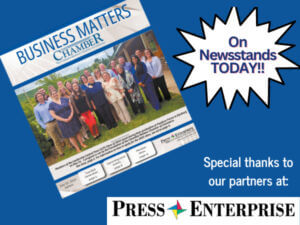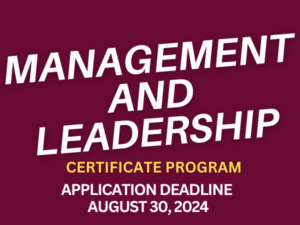July Business Matters Hits Newsstands

Thanks again to our partner The Press Enterprise, the newest edition of Business Matters has officially hit newsstands (today)! Inside the edition, you'll see a recap of the last quarter's member news highlights, ribbon cuttings, events, and more. You'll also learn about upcoming programs and events, and business news that will impact your business in the coming months. Special thanks to Special Editions Editor Shawn Stair for another wonderful publication.
Mathematics for Decision-making: The 37% Rule
Have you ever been stuck between multiple options and simply unable to make a decision? Of course, you have — you're a human being. While the human brain is the most complex computing system known to man, people are still prone to finding big life decisions difficult. Nobody likes being paralyzed by a decision, yet it happens to all of us. What if we told you there was a magic number, a decision statistic, that could help you out of those difficult moments?
Mathematicians have discovered a number that they believe we can use to make any type of difficult decision. Whether you're deciding figure which of your 10 dates are the best pick, which house you should buy or which job to choose, this rule can help.
The 37% Rule
 The underlying tenet is that if you have to choose among 100 possibilities, you should sample the first 37 and ignore (or postpone) the rest. The 37% rule is not some automated, unthinking process. It's a phase of calibration where you figure out what works and what doesn't. We select the finest from the rejected 37% and preserve that knowledge in our thoughts going ahead. If any future possibilities outperform that benchmark standard, you should choose them in order to get the greatest possible result.
The underlying tenet is that if you have to choose among 100 possibilities, you should sample the first 37 and ignore (or postpone) the rest. The 37% rule is not some automated, unthinking process. It's a phase of calibration where you figure out what works and what doesn't. We select the finest from the rejected 37% and preserve that knowledge in our thoughts going ahead. If any future possibilities outperform that benchmark standard, you should choose them in order to get the greatest possible result.
The mathematically-minded may check out a more in-depth explanation of this weirdly specific advice. Mathematicians maintain that following this rule will increase your chances of selecting the best decision.
Exploit Versus Explore
The "explore/exploit" trade-off in psychology and economics. This questions if you should choose a surefire win (exploit) or take a chance choosing a different route with an unknowable result (explore). Certain variables, like how curious or risk-averse you are, influence how much you will investigate or exploit.
The extremes of being very exploratory or overly exploitative put us at a disadvantage. A person who investigates excessively runs the danger of becoming a "jack of all trades, master of none," whereas a person who exploits excessively may develop habits. So, how does it work in real life?
How to Apply the 37% Rule
Mathematicians think that we can use this rule in every area of life. To come to a statistically optimal decision on anything, you can apply it and know you're in the hands of science. Here are a few real-life examples of how to use this rule.
Dating
This rule says that if you're planning to go on 10 dates, you should enjoy the first three (3.7) but don't make any commitments. Then, the very next person you date who is better than any of those three should be the one you choose to settle with. According to the research, this is the perfect statistical balance between being exploratory and exploitative.
Job Hunting
If you plan on doing 100 job interviews, this rule says that you do 37 noncommittally, without having the intention to take any of them. Then, when you find the first thing that beats any of those first 37 options, take that one.
Humans are naturally analytical, but we can't always do the right thing. There's always an optimal decision to be made, but our tendencies to be risk aversion or overly exploratory might sometimes steal it from us. You can apply this to your personal and business decisions to avoid missing out on the optimal choice.
If you benefit from topics like this, consider joining the 2025 Class of Leadership Central Penn. For more information about LCP talk with Tonya Smith, Director of the Foundation of the Columbia Montour Chamber at foundation@columbiamontourchamber.com or at 570-784-2522 ext. 407.
Last week in Legislature
Source: PA Chamber of Business and Industry
With negotiations still ongoing, the state House of Representatives and Senate returned to Harrisburg last week to continue working on the 2024-25 state budget, accompanying code bills, and other legislative initiatives tangentially related to the annual spending plan.
Despite missing the June 30 budget deadline, reports indicate that talks continue between the Shapiro administration, Democrat-controlled House, and Republican-controlled Senate. Legislative leaders have expressed optimism in their quest to reach an agreement.
Additionally, lawmakers are also taking action on a range of bills, unrelated to the state budget, relevant to the employer community. These include proposals related to antitrust, health care, education, and more.
Below is a rundown of legislative action that was taken by House and Senate lawmakers last week:
 Anti-Trust Expansion (H.B. 2012)
Anti-Trust Expansion (H.B. 2012)
The House of Representatives voted 112-89 to pass House Bill 2012 last Tuesday.
This legislation would create a Pennsylvania anti-trust statute that would expand anti-trust provisions and require pre-merger notifications to the Attorney General’s Office for health care facilities. The language of what constitutes a violation is sweeping and ambiguous, subjecting the Commonwealth’s employer community to severe criminal penalties and costly civil liability based upon undefined standards.
The bill expands anti-trust powers for the Attorney General and creates private causes of action that will allow for private anti-trust lawsuits in state courts across the Commonwealth. Additionally, the pre-merger notification requirement will subject health care mergers to additional scrutiny well below the current thresholds for reporting to the FTC and the DOJ.
Along with a coalition of leading employer groups, we opposed this legislation (CLICK HERE for our letter to lawmakers), which now heads to the Senate for committee consideration.
Health Care Transactions (H.B. 2344)
The House Rules Committee voted 18-15 to advance House Bill 2344 last Monday.
This legislation would empower the Pennsylvania Attorney General to unilaterally determine the fate of every health care industry transaction in Pennsylvania and decide whether the transaction is “against the public interest.”
The bill creates a new, duplicative, and bureaucratic review process while placing the sole financial cost for the process back onto our health care systems, with no limits. This legislation is duplicative of existing state and federal processes and adds power to a single government agency to subjectively determine if health care transactions are “against the public interest.”
We opposed this legislation (CLICK HERE for our memo). House Bill 2344 is now pending before the full House.
Ready-to-Drink Products (S.B. 688)
The House of Representatives voted 163-38 to pass Senate Bill 688 last Tuesday.
This legislation would authorize the private sector to sell “Ready to Drink” adult beverages.
“Ready to Drink” cocktails are a popular alcoholic beverage product that currently can only be purchased through state stores. It is simply unfair to deny local convenience stores and supermarkets the ability to respond to their customers and sell these products.
We supported this legislation (CLICK HERE for our memo), which has been referred to the Senate Rules and Executive Nominations Committee.
Allowing Highly Qualified Individuals to Receive CTC Certificates (S.B. 700)
The House Education Committee voted unanimously (25-0) to pass Senate Bill 700 last Monday.
This legislation would amend the requirements to receive a CTC teaching certificate to more readily allow highly qualified individuals to transition from the private sector to the classroom.
The bill will help ease the Commonwealth’s workforce shortage, particularly in technical and trades jobs, by ensuring Pennsylvania’s career and technical centers are equipped with the brightest educators.
We supported this legislation (CLICK HERE for PA Chamber of Business and Industry memo), which is now pending before the full House.
###
The Columbia Montour Chamber of Commerce closely monitors proposed legislation and its potential impact on the local business community. Businesses are encouraged to offer feedback to Chamber President Chris Berleth, at cberleth@columbiamontourchamber.com.
Founded in 1916, the Pennsylvania Chamber of Business and Industry is the state's largest broad-based business association, with its membership comprising businesses of all sizes and across all industry sectors. The PA Chamber is The Statewide Voice of BusinessTM.
Enhancing Workplace Satisfaction Through Employee Recognition Programs
- Employee recognition programs are essential for boosting morale, productivity, and job satisfaction through awards, bonuses, and public acknowledgment.
- Such programs create a motivational environment, fostering a sense of accomplishment and belonging among employees.
- Effective recognition reduces turnover rates, with studies showing over 40% higher engagement and less likelihood of employees quitting when recognized.
- Implementing an effective recognition system involves setting clear goals, ensuring fairness, and using platforms that fit the company's culture.
- Regular acknowledgment, even through simple gestures like saying "thank you," plays a crucial role in creating a positive workplace culture and encouraging high performance.
607 ~ 3 min. read
 Employee satisfaction directly correlates with productivity, morale, and overall workplace harmony. Recognizing and appreciating employees' efforts can significantly boost their job satisfaction. Read on to learn more about increasing workplace satisfaction through effective employee recognition programs and practical tips on implementing them.
Employee satisfaction directly correlates with productivity, morale, and overall workplace harmony. Recognizing and appreciating employees' efforts can significantly boost their job satisfaction. Read on to learn more about increasing workplace satisfaction through effective employee recognition programs and practical tips on implementing them.
What Are Employee Recognition Programs?
Employee recognition programs are formal or informal initiatives designed to acknowledge and reward employees for their hard work and dedication. These programs can include a variety of components such as awards, bonuses, thank you notes, and public recognition. The primary aim is to create a motivational environment that fosters a sense of accomplishment and belonging.
Benefits of Employee Recognition Programs
Implementing a well-thought-out recognition program can have profound benefits. Firstly, it boosts employee morale by making individuals feel valued and appreciated. Enhanced job satisfaction naturally follows, as employees are more likely to take pride in their work. Recognition also plays a critical role in reducing turnover rates, as employees who feel acknowledged are less likely to seek opportunities elsewhere. Recent studies reveal that employees feel over 40% more engaged when their managers are good at giving recognition compared to those with less skilled managers. Also, these employees show higher confidence, better memory retention, more willingness to commit, and are less likely to quit their jobs. Additionally, a positive recognition culture can improve overall productivity and performance, as motivated employees tend to be more focused and committed to their tasks.
Implementing a Robust Recognition System
Developing an effective recognition program involves several key steps. Organizations should begin by defining the goals of the program and determining the types of recognition that will be most impactful. Essential elements to include are awards, bonuses, and thank you notes, tailored to fit the company's culture. Ensuring consistency and fairness is crucial; all employees should have equal opportunities to be recognized, and the criteria for recognition should be transparent. Some companies specialize in all-in-one recognition platforms. People Managing People, a human resources firm, shared these 30 platforms to celebrate employee accomplishments and foster a culture of acknowledgement in the workplace.
Examples of Effective Recognition Programs
Several companies stand out for their exceptional recognition programs. For instance, Google’s peer-to-peer recognition system allows employees to thank each other publicly for exceptional work, fostering a culture of mutual appreciation and an opportunity for cash bonuses. Smaller businesses can also implement effective programs; for example, a small tech startup might use monthly awards and team outings to recognize and reward outstanding efforts.
Regular Acknowledgment and Its Impact
Never underestimate the impact of expressing gratitude with a simple "thank you." This small gesture can have a powerful effect, fostering a positive atmosphere, strengthening relationships, and acknowledging the efforts and contributions of others. Regular acknowledgment, even through informal channels, creates a culture of appreciation that permeates the workplace. This culture not only boosts morale but also encourages employees to maintain high performance levels, knowing their efforts will not go unnoticed.
Challenges and Solutions
Implementing recognition programs is not without challenges. Common pitfalls include a lack of consistency, perceived unfairness, and insufficient funding. To overcome these challenges, organizations should set clear guidelines, maintain transparent communication, and seek cost-effective solutions such as non-monetary recognition. It's important to reward more than just performance. Recognize efforts, process improvements, value demonstrations, and innovations, not just outcomes.
The Takeaway
Recognizing employees is key to improving workplace happiness. Investing in a system that boosts morale, makes jobs more satisfying, and creates a better work atmosphere changes the company culture for the better. When companies acknowledge their employees' hard work, they often see not just more productivity but also greater success overall.
---
The Columbia Montour Chamber of Commerce is a private non-profit organization that aims to support the growth and development of local businesses and our regional economy. We strive to create content that not only educates but also fosters a sense of connection and collaboration among our readers. Join us as we explore topics such as economic development, networking opportunities, upcoming events, and success stories from our vibrant community. Our resources provide insights, advice, and news that are relevant to business owners, entrepreneurs, and community members alike.
50+ Local Chambers of Commerce Across PA Urge State Investments inChild Care Teacher Recruitment and Retention
 Local chambers of commerce from across Pennsylvania, including the Columbia Montour Chamber of Commerce submitted a letter to state lawmakers urging them to address Pennsylvania’s continuous child care crisis. The letter, signed by more than 50 local chambers of commerce and economic development agencies, calls for a state investment that directly helps child care providers to recruit and retain their teachers. The letter explains, alleviating the child care workforce shortage, means classrooms can remain open or reopen, increasing the availability of child care for the tens of thousands of families that need it to remain in the workforce and contribute to Pennsylvania’s overall economy.
Local chambers of commerce from across Pennsylvania, including the Columbia Montour Chamber of Commerce submitted a letter to state lawmakers urging them to address Pennsylvania’s continuous child care crisis. The letter, signed by more than 50 local chambers of commerce and economic development agencies, calls for a state investment that directly helps child care providers to recruit and retain their teachers. The letter explains, alleviating the child care workforce shortage, means classrooms can remain open or reopen, increasing the availability of child care for the tens of thousands of families that need it to remain in the workforce and contribute to Pennsylvania’s overall economy.
A new report from the nonprofit ReadyNation surveyed more than 300 PA working mothers and estimated an annual economic cost of $2.4 billion in lost earnings, productivity, and tax revenue due to gaps in Pennsylvania’s child care system.
According to the report, the vast majority of child care responsibility still falls on mothers – therefore, work disruptions, career barriers and financial burdens caused by inadequate child care are greater for working moms as a percentage of earnings than all working parents. The annual economic cost of both working mothers and fathers dealing with gaps in PA’s child care system is estimated at $6.65 billion annually.
As part of the letter, local chamber leaders point to numerous states that are navigating the child care teacher shortage crisis that is closing programs and driving up waitlists for working families in need of care. At least 18 states are directly investing in recruitment and retention strategies to solve the child care teacher shortage and ensure that child care supply can meet the demand from working families.
Click here to learn more about the child care in Pennsylvania.
###
Businesses are encouraged to offer feedback to Chamber President Chris Berleth, at cberleth@columbiamontourchamber.com on this topic or others that impacting your business.
SCOTUS Ruling Creates More Stable Regulatory Environment for Business
Source: U.S. Chamber of Commerce
 In its decision in the Loper Bright and Relentless cases, the Supreme Court overturned its 40-year-old administrative law precedent from Chevron v. Natural Resources Defense Council, taking a major step toward improving the regulatory environment for businesses.
In its decision in the Loper Bright and Relentless cases, the Supreme Court overturned its 40-year-old administrative law precedent from Chevron v. Natural Resources Defense Council, taking a major step toward improving the regulatory environment for businesses.
Why it matters: The court made an important course correction that will help create a more predictable and stable regulatory environment for businesses.
Be smart: Under the longstanding Chevron deference doctrine, judges deferred to federal agencies’ reasonable interpretations of ambiguous statutes.
• This created an unpredictable and unstable regulatory climate for businesses.
• Now, courts will exercise full, independent judgment in deciding whether an agency has acted within its statutory authority.
The U.S. Chamber of Commerce take: “The Supreme Court’s previous deference rule allowed each new presidential administration to advance their political agendas through flip-flopping regulations and not provide consistent rules of the road for businesses to navigate, plan, and invest in the future,” said U.S. Chamber of Commerce President and CEO Suzanne P. Clark. “The Chamber will continue to urge courts to faithfully interpret statutes that govern federal agencies and to ensure federal agencies act in a reasonable and lawful manner."
What the U.S. Chamber did: The U.S. Chamber filed an amicus brief, urging the Court to reject the practice of reflexive judicial deference to agency interpretations of statutes under an expansive interpretation of Chevron deference.
Innovative Hiring Strategies for Small Businesses
- Securing top talent is essential for small business growth, facing unique recruitment challenges.
- Innovative hiring strategies, like leveraging social media and advanced technologies, enhance recruitment and provide a competitive edge.
- Over 71% of recruiters use social media for hiring, tapping into a wider talent pool and engaging with candidates in a relaxed environment.
- AI-driven applicant tracking systems improve efficiency in identifying ideal candidates.
- Creating a strong employer brand is crucial for attracting top talent and differentiates company branding.
730 words ~ 3.5 min read
 Securing the right talent is crucial for growth, especially for small businesses facing unique recruitment challenges. The hiring landscape is constantly changing, requiring small business owners to be flexible and adopt innovative recruitment strategies to stay competitive.
Securing the right talent is crucial for growth, especially for small businesses facing unique recruitment challenges. The hiring landscape is constantly changing, requiring small business owners to be flexible and adopt innovative recruitment strategies to stay competitive.
Leveraging social media and advanced technologies in recruitment can significantly enhance a small business's ability to attract top talent and gain a competitive edge. Posting job opportunities on social media is just the start; you want to use social media to build your employer brand. Advanced technologies like AI-driven applicant tracking systems can make the recruitment process more efficient, especially when they build in innovations that allow you to identify ideal candidates easily. Creating an employer brand, not just a company brand, is also essential to attracting your ideal hires. Read on to learn more about these strategies and to discover expert-recommended tools for recruitment and hiring.
Using Social Media for Recruitment
Social media platforms have transformed into vital recruitment tools, with over 71% of recruiters using these platforms for hiring. LinkedIn, Facebook, and Twitter not only enable businesses to tap into a wider talent pool but also facilitate engagement with potential candidates in a more relaxed environment, enhancing the recruitment process.
Benefits:
- Wider Reach: Social media platforms have millions of active users, providing access to a vast pool of potential candidates. Also, when you talk about new opportunities on social media platforms, you make it easy for happy team members to tell others about it.
- Targeted Advertising: Businesses can use targeted ads to reach specific demographics based on the ideal candidate's profile. Companies like Boostpoint help businesses receive a greater ROI and enable them to reach candidates with sophisticated targeting and AI innovations.
- Employer Branding: Establishing a strong presence on social media helps build a reputable employer brand, attracting quality candidates, even customers who already love your business. In the last section, we’ll outline how to create an employer brand that helps you achieve your goals.
Leveraging Recruitment Technology
Technology has revolutionized the recruitment process, making it more efficient and effective. Utilizing advanced recruitment tools can streamline hiring and enhance the candidate experience.
Key Technologies:
- Applicant Tracking Systems (ATS): These systems help manage the entire recruitment process, from posting job ads to tracking applications and scheduling interviews. In 2024, Freshteam by Freshworks ranked best out of eleven ATS providers as ranked by Forbes, and the US Chamber of Commerce spotlight four other ATS companies ideal for small business in a recent article.
- AI and Machine Learning: These technologies, often built into your ATS, can analyze resumes, shortlist candidates, and even conduct initial interviews, saving time and resources.
- Video Interviewing: Video interviews allow businesses to screen candidates remotely, reducing the time and cost associated with in-person interviews. People Managing People article, list Vidrecruiter and Hireflex as top video software for interviews in 2024. View their complete list and how to choose a software that’s right for you here.
Creating an Attractive Employer Brand
An attractive employer brand can significantly impact a small business's ability to attract and retain top talent. A strong employer brand communicates the company's values, culture, and mission, making it an appealing place to work.
Strategies to Enhance Employer Brand:
- Employee Testimonials & Spotlights: Sharing employee experiences and testimonials on the company website and social media can showcase the positive aspects of working for the business. Spotlighting team members' passions and contributions can also help attract like-minded candidates. Stories, inc., a digital marketing agency focused on telling employee stories, compiled a list of great employee stories to help businesses tell their own. Go here for inspiration.
- Engaging Content: Regularly posting engaging content, such as behind-the-scenes videos, team-building activities, and success stories, helps create a positive image. Use your mission to help guide content so that candidates and customers learn what you value. Additionally, think about showcasing how your business backs communities vital to you, including veterans, educational institutions, families, and local businesses.
- Career Development Opportunities: Highlighting opportunities for career growth and professional development can attract ambitious candidates looking for long-term prospects. Tell stories about employees moving up and how their work supports the company vision.
The Takeaway
By focusing on these innovative hiring strategies, small business owners can stay ahead of the curve, optimize their operations, and drive growth in their respective industries. Embracing these trends will not only help in finding the best talent but also ensure that the business remains competitive in the ever-evolving market landscape.
---
The Columbia Montour Chamber of Commerce is a private non-profit organization that aims to support the growth and development of local businesses and our regional economy. We strive to create content that not only educates but also fosters a sense of connection and collaboration among our readers. Join us as we explore topics such as economic development, networking opportunities, upcoming events, and success stories from our vibrant community. Our resources provide insights, advice, and news that are relevant to business owners, entrepreneurs, and community members alike.
Member News ~ July 8, 2024
Bloomsburg Parking and App information
- Parking Brochure
- Passport Press Release
- New Passport Parking Instructions
- Merchant Validation Information
"On Track" out now!
Check out the North Shore Railroad Company & Affiliates quarterly newsletter.
Central PA Energy Summit Happening July 22
Participate in the Central PA Energy Summit to delve into the topic of energy affordability and accessibility within Central PA. Learn more here.
BOOM Camps happening
Better Orientation Onboarding & Mentoring (BOOM) Camps will be hosted free and online in July. Get dates, and session topics and register by clicking here. Help BOOM Camp by participating in a survey that will gather insights from local employers to develop valuable learning content for HR professionals, business leaders, workforce development experts, and educators in Central PA. A summary will be shared with BOOM Camp participants and available by request. The final report will be ready by summer 2024.
Sean Black - State Farm Celebrating 12 years in business
Congratulation to Sean Black and his team on celebrating their 12th year in business!
7 Mountains Media Launches Second Chance Job Board
7 Mountains Media is proud to announce the launch of the Second Chance Job Board on freshstartpa.net, providing a platform for employers to offer job opportunities to individuals with criminal backgrounds. Employers are invited to list job openings for free, helping to create a fresh start for those looking for a second chance. Learn more.
Update your Veolia Account
Want to keep updated on work in your area? Ensure your phone and email address are up to date in your account on: mywater.veolia.us
They will only notify you about planned and unplanned work in your area if these features are turned on.
Rental Assistance Virtual Meeting Happening July 11th
Central Susquehanna Opportunities, Inc. (CSO), in collaboration with Agape and Gate house, is applying for HOME ARP Support Service funding to support housing programming in Columbia, Montour and Northumberland Counties! This funding will be used to provide rental assistance and homelessness prevention service to eligible families! Curious about this or wondering if you or someone you know qualify?
Join a virtual meeting that is open to the public on July 11th at 10am!
Please contact Megan Bair for questions: mbair@censop.com
IMC Partnering to Offer Electrical Safety Training
The Innovative Manufacturers’ Center (IMC), Inc. is excited to announce its continued partnership with The Manufacturers' Association to support training in electrical safety in central and southcentral Pennsylvania through December 2024. Open enrollment opportunities scheduled are as August 7 – Altoona, August 21 – Williamsport, September 9 – Lewisburg, and October 8 – State College. Learn more.
Bloomsburg Children's Museum Hosting Daddy Daughter Dance
The Friends of the Bloomsburg Children’s Museum (BCM) will host its 3rd annual Daddy Daughter Dance on Sunday, July 28 from 3-6 p.m. at the Museum, 2 West 7th Street, Bloomsburg. Daughters may be escorted by dad, grandpa, Uncle, or any special person who fits this role. Learn More.
Danville Memorial Park 2024 Concert Series happening Tuesdays
Bring your lawn chair and gather in Memorial Park for the annual Summer Concert Series, Tuesdays at 7 pm (til dusk) Rain Location: Grove Presbyterian Church. Stay up to date on performers and rain location changes here.
Pennsylvania College of Technology offers Workforce Development Courses
Check out PCT's full listing of Workforce Development Courses happening all year long! Courses include Excel Training and Fundamentals of GD & T.
Construction and Maintenance Training Programs offered at CMAVTS
This workforce development opportunity is provided by Columbia County Commissioners in partnership with Community Strategies Group and funded by the COVID-19-ARPA, Whole-Home Repairs Program Funds. This program is tuition-free for Residents of Columbia County. Training is provided by Columbia-Montour Area Vocational Technical School. For more information and to register for a course, call 570-784-8040, extension 3320, and check out the course schedule here.
Upcoming Bucknell SBDC Events
- July is Independent Retailer Month! Learn ways to make the most of this month for you business.
- Partnering for Progress: Bucknell Students & Faculty Ready to Help Your Business - Two Session opportunities - 8:30 on July 9th OR 3:30 on July 10th.
Servpro of Columbia, Montour & Sullivan Counties offering CE classes
5 CE classes will be offered by Servpro of Columbia, Montour & Sullivan Counties. Get the full schedule.
Covered Bridge & Arts Festival Call for Vendor Applications
The 2024 Application is NOW AVAILABLE for all returning vendors and prospective new vendors. The application is the same whether you are a returning or new vendor. RETURNING VENDORS: please submit as soon as possible to receive priority consideration. The application window for prospective NEW vendors will remain open until JULY 15. Get more details here.
Save the Date for Agapepalooza
Save the Date for Agapepalooza July 20th, 2024. This is a day of free fun for the whole family with activities, local vendors, and food. Learn more.
LCBC hosting annual Global Leadership Summit
For over 30 years, the Global Leadership Summit has been empowering leaders worldwide. LCBC will be hosting this virtual summit at their Columbia - Montour Campus on August 8-9. Learn more.
Bloomsburg Rotary Hosting 30th Annual Jeffrey H. Lewis Memorial "Kids Klassic"
Wednesday, August 14th will see the 30th Annual Jeffrey H. Lewis Memorial "Kids Klassic" at Frosty Valley Resort. Learn more.
3rd Annual Photo contest hosted by Journey Bank
Community Giving Foundation partnering on a regional nonprofit Conference in October
Community Giving Foundation and First Community Foundation Partnership of Pennsylvania (FCFP) are thrilled to partner together to create Elevate2, a new regional nonprofit conference. The inaugural conference will be held on October 14-15, 2024, at Bucknell University in Lewisburg. More information is available online at elevate2.org
Women's Center to Celebrate Anniversary
Save the Date for the 50th Anniversary Celebration of the Women's Center of Columbia and Montour Counties happening November 16, 2024.
Member News ~ June 28, 2024
Bloomsburg Parking and App information
- Parking Brochure
- Passport Press Release
- New Passport Parking Instructions
- Merchant Validation Information
Central PA Energy Summit Happening July 22
Participate in the Central PA Energy Summit to delve into the topic of energy affordability and accessibility within Central PA. Learn more here.
Geisinger Offers Stop the Bleed Training
As part of the national Stop the Bleed campaign Geisinger Medical Center participates in community outreach for the public on how to manage life-threatening bleeding until Emergency Medical Services (EMS) or first responders arrive. To learn more about the program and have a training at your business click here.
7 Mountains Media Launches Second Chance Job Board
7 Mountains Media is proud to announce the launch of the Second Chance Job Board on freshstartpa.net, providing a platform for employers to offer job opportunities to individuals with criminal backgrounds. Employers are invited to list job openings for free, helping to create a fresh start for those looking for a second chance. Learn more.
PPL Offers Tips for Heat Wave
PPL Electric offers these tips for customers to save energy and money while still staying comfortable during extreme heat. Learn more.
IMC Partnering to Offer Electrical Safety Training
The Innovative Manufacturers’ Center (IMC), Inc. is excited to announce its continued partnership with The Manufacturers' Association to support training in electrical safety in central and southcentral Pennsylvania through December 2024. open-enrollment opportunities scheduled are as August 7 – Altoona, August 21 – Williamsport, September 9 – Lewisburg, and October 8 – State College. Learn more.
Railroad Military Locomotives to be on Display in Celebration of Independence Day
The North Shore Railroad Company & Affiliates (NSHR) will have its two Military Units parked, for public viewing, at the Union County Veterans’ 4th of July Celebration (on Saturday, June 29th, in Lewisburg, PA) and Set the Night to Music Fireworks Celebration (on Thursday, July 4th, in Williamsport, PA). Learn More.
CMVTS students competing at Conference
Bloomsburg Children's Museum Hosting Daddy Daughter Dance
The Friends of the Bloomsburg Children’s Museum (BCM) will host its 3rd annual Daddy Daughter Dance on Sunday, July 28 from 3-6 p.m. at the Museum, 2 West 7th Street, Bloomsburg. Daughters may be escorted by dad, grandpa, Uncle, or any special person who fits this role. Learn More.
Updated Contact information for PPL
Check out the updated contact information flyer for PPL.
Danville Memorial Park 2024 Concert Series happening Tuesdays
Bring your lawn chair and gather in Memorial Park for the annual Summer Concert Series, Tuesdays at 7 pm (til dusk) Rain Location: Grove Presbyterian Church. Stay up to date on performers and rain location changes here.
Geisinger Medical Center road relocation project to begin in June
This June, Geisinger Medical Center will begin the first phase of its road relocation project on Medical Center Drive in front of the hospital. The roadwork will happen in multiple phases and is expected to be completed in early 2025. The work is expected to start Monday, June 3, weather permitting. Learn more.
Ready PA - When Thunder Roars, Go Indoors - June Edition 2024
June 2024 ReadyPA Newsletter is out now articles this month include Lightning Safety Awareness Week (When Thunder Roars, Go Indoors!); Enjoy A Safe & Fun Filled Summer, and Hey Pet Parents! It's Pet Preparedness Month!
Pennsylvania College of Technology offers Workforce Development Courses
Check out PCT's full listing of Workforce Development Courses happening all year long! Courses include Excel Training and Fundamentals of GD & T.
Construction and Maintenance Training Programs offered at CMAVTS
This workforce development opportunity is provided by Columbia County Commissioners in partnership with Community Strategies Group and funded by the COVID-19-ARPA, Whole-Home Repairs Program Funds. This program is tuition-free for Residents of Columbia County. Training is provided by Columbia-Montour Area Vocational Technical School. For more information and to register for a course, call 570-784-8040, extension 3320, and check out the course schedule here.
Upcoming Bucknell SBDC Events
- Partnering for Progress: Bucknell Students & Faculty Ready to Help Your Business - Two Session opportunities - 8:30 on July 9th OR 3:30 on July 10th.
Servpro of Columbia, Montour & Sullivan Counties offering CE classes
5 CE classes will be offered by Servpro of Columbia, Montour & Sullivan Counties. Get the full schedule.
BOOM Camps happening
Better Orientation Onboarding & Mentoring (BOOM) Camps will be hosted free and online April - July. Get dates, session topics and to register by clicking here.
Covered Bridge & Arts Festival Call for Vendor Applications
The 2024 Application is NOW AVAILABLE for all returning vendors and prospective new vendors. The application is the same whether you are a returning or new vendor. RETURNING VENDORS: please submit as soon as possible to receive priority consideration. The application window for prospective NEW vendors will remain open until JULY 15. Get more details here.
Save the Date for Agapepalooza
Save the Date for Agapepalooza July 20th, 2024. This is a day of free fun for the whole family with activities, local vendors, and food. Learn more.
Stay Connected to the Women's Giving Circle
"On the Bright Side" Sessions will continue on August 15th and November 14th and their Annual Meeting & Grant Presentations will happen July 17th. Learn more about these events and what the Women's Giving Circle is all about!
LCBC hosting annual Global Leadership Summit
For over 30 years, the Global Leadership Summit has been empowering leaders worldwide. LCBC will be hosting this virtual summit at their Columbia - Montour Campus on August 8-9. Learn more.
Bloomsburg Rotary Hosting 30th Annual Jeffrey H. Lewis Memorial "Kids Klassic"
Wednesday, August 14th will see the 30th Annual Jeffrey H. Lewis Memorial "Kids Klassic" at Frosty Valley Resort. Learn more.
3rd Annual Photo contest hosted by Journey Bank
Community Giving Foundation partnering on a regional nonprofit Conference in October
Community Giving Foundation and First Community Foundation Partnership of Pennsylvania (FCFP) are thrilled to partner together to create Elevate2, a new regional nonprofit conference. The inaugural conference will be held on October 14-15, 2024, at Bucknell University in Lewisburg. More information is available online at elevate2.org
Commonwealth University – Bloomsburg Campus and The Columbia Montour Chamber of Commerce to offer management and leadership program

Back by popular demand, Commonwealth University of Pennsylvania – Bloomsburg Campus and the Columbia Montour Chamber of Commerce will once again offer their Management and Leadership program to help develop and sharpen skills for leading in today’s workplace environment.
This five-module certificate program is appropriate for existing leaders, managers, and supervisors; or those who are new or emerging in any business sector.
Professional course materials include assessments, activities, and other learning enhancement components to help each participant individualize their learning experience. Participants will receive a certificate from Commonwealth University upon completion and will have identified personal development goals to provide to their employers.
The five, three-hour modules are: supervisor effectiveness; effective communication for managers; conflict management; navigating a multigenerational workforce; and being a great mentor or coach.
This Fall’s Cohort will take place at the Hub at Mulberry Mill, 160 W. 6th Street Bloomsburg, PA 17815 from 10 A.M. to 2 P.M. on the following dates: September 12, October 3, October 17, October 31, and November 14. This year, special consideration for scheduling means that the program will not conflict with the Bloomsburg Fair.
Complete program details are available at www.columbiamontourchamber.com/employee-development/ or by calling 570-784-2522.
The program qualifies for WEDnet funding. For eligibility information, visit wednetpa.com or contact Jennifer Williams at 570-389-4004 or jwilliam@commonwealthu.edu.
